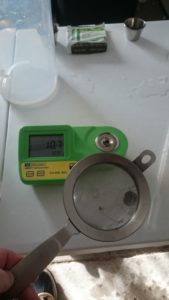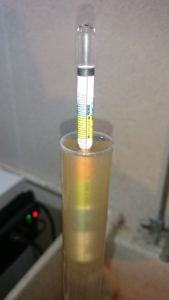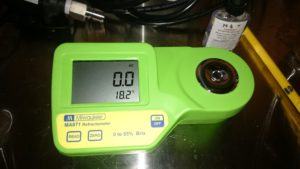
Hands on Review: Milwaukee MA871 Digital Refractometer
This review is by Homebrew Finds Contributor Brad Probert. Brad is an engineer, expert homebrewer and experienced reviewer. Grab a link to Brad’s website at the end of this review.
Those floating glass bobbers seem cool when you start homebrewing. They make you feel like you’re doing something complicated and sophisticated with your test tubes and fine crafted thin-glass instrument, and have a cool name- hydrometer. Then you break it. Oh well, bound to happen eventually, right? So you buy another one, and it eventually meets its doom, too. Soon, you start to do the math on the attrition rate, and figure out how long before you’d pay for a refractometer and you make that step.
If you’ve taken that step already, you can skip over this paragraph. For me, it was life changing. I was suddenly able to take multiple gravity measurements all through my brew process without burning through sample tube volumes of wort. I could monitor pre-boil gravity during sparge and figure out when I needed to shut down the sparge if things were coming in low on gravity, top off with water if I overachieved, or play with other variables like boil time to boil off more water if needed. And not having to read a refractometer is akin to the joy you feel when your kids are finally out of diapers and you don’t have to deal with that any more. Meniscus is a fun word to say, but when reading your gravity, it’s painfully vague. The constant slow turning of the hydrometer that always seems to leave the side with gravity units just out of view- I don’t miss it at all.
The standard refractometer is fairly reliable and easy to use, so you might rightly be wondering why you’d need to take the extra step up in $ to go to a digital one. It’s definitely not the same sort of life-changing experience like it is when you walk away from your hydrometer and your world opens up to refractometers. Digital refractometers work in the exact same way as the “analog” ones, looking at how light bends when it goes through your wort sample and determining your gravity. And because of that light bending thing, they get confused when you start to have alcohol present. So if you’re measuring samples from your fermenting beer, you have to run it through a refractometer adjustment calculator that makes some estimated adjustments based on the OG you started with. But typing in my reading to a calculator is such a minor inconvenience compared to sample jars, bubbles, and that darn meniscus.
The digital refractometer does all the same things as an analog refractometer, it just makes them a bit simpler. You no longer have to stare through the eyepiece and see if you can pass your eye test and accurately determine if that blue line crosses at 1.042 or 1.044. And the digital meter has no human bias factor of pushing OG readings to be a bit higher and FG readings to be a bit lower (c’mon, we’ve all done it). It just reads it and reports the number. No ambiguity.
Featured in this review: Milwaukee MA871 Digital Sugar Refractometer affiliate link, note that multiple variations of this product may be available, as such a different version may appear at this link
Hands on Review
I tried out the MA871 digital refractometer from Milwaukee Instruments. It comes in a well-made plastic shell that is a unique shade of green. It is portable and lightweight- not quite “smartphone portable” but maybe more “1990s cell phone portable”. Aside from the hard plastic ABS material of its body, the sample well is a miniature stainless steel shallow bowl that takes a few drops from your sampling dropper to get a reading.
It does not tolerate floaters very well in solution (hop bits or malt fragments), and at first I struggled with this. My readings would vary wildly, to the point that I was spot-checking them with my analog refractometer. Regular refractometers do also suffer from this same weakness because they’re measuring gravity in the same way- how light bends through the sample. Bits of floating hop pellets tend to get in the way and skew your results.
I tried two methods to try to deal with this. The first was a little hand-sized fine mesh strainer I picked up from the Meijer kitchenware section, the other was one of those loose tea strainers with a mesh of tiny holes. I thought the loose tea strainer would be best because the tiny holes would keep out any debris. Problem was it even kept out the beer, and I could get my sample to even come through. The fine-mesh strainer from Meijer worked great, and my measurement repeatability was spot-on.
 Using a fine mesh strainer [Oneida 4″ Fine Mesh Strainer – via Wal-Mart] to filter wort for reliable testing
Using a fine mesh strainer [Oneida 4″ Fine Mesh Strainer – via Wal-Mart] to filter wort for reliable testing
The one downside for me is it only reads out in % Brix [see below for a calculator that can convert to SG]. My beer brewing brain seems to only really process in units of Specific Gravity, and I haven’t trained it yet to be able to think in Brix, so it means always plugging it in to a calculator on my phone. The meter is accurate to +/- 0.2% Brix, which is the same as 0.0008 SG, or 0.8 Gravity units. That’s the same as some higher end ($100+) analog refractometers, but you don’t have the variable of your source light wavelength (the MA871 uses its own internal light source rather than whatever your internal lighting temperature is or outdoor daylight). You also don’t have the variability of your eye accurately reading the blue line versus the tiny black marks. Lastly, the desktop meter allows you to more easily use the mini strainer method I mentioned to get rid of particles affecting your reading, as you don’t need a third hand to hold your meter flat.
 Hydrometers have some downsides. They are made of easy to break glass, the hydrometer should be straight up and down for an accurate reading and they can be difficult to read.
Hydrometers have some downsides. They are made of easy to break glass, the hydrometer should be straight up and down for an accurate reading and they can be difficult to read.
In conclusion, there don’t seem to be any hidden tricks to justify throwing away your analog refractometer and going digital. But if you’re making the step from a hydrometer, it might be the way to go. Especially if you’re a number freak like me and sources of measurement error frustrate you. The digital meter gets rid of the optical guesswork and does allow easier sample filtering to remove hop debris “noise” from your measurements. You’ll need to decide for yourself how much that’s worth to you.
Milwaukee MA871 Digital Sugar Refractometer with Automatic Temp Compensation, Yellow LED, 0 to 85 percent Brix, +/- 0.2 percent Accuracy, 0.1 percent Resolution affiliate link, note that multiple variations of this product may be available, as such a different version may appear at this link
Also: Oneida 4″ Fine Mesh Strainer – via Wal-Mart
Note from HBF: Refractometers can be used to measure gravity throughout the brewing process. You can also estimate the alcohol content of your beer if you forget to take an OG with the use of a refractometer and a hydrometer. Check out Sean Terrill’s excellent refractometer calculator.
Looking for a deal? Homebrew Refractometer Deals, Discounts and Coupons
Special Thanks to Milwaukee Instruments for providing the unit used used for evaluation in this review.
By Brad Probert. Check out Brad’s website – beersnobby.com
pinnedThis post may contain affiliate links. We may make a commission when you use our links. This will never cost you extra. Thank you for supporting Homebrew Finds!
greatdealsreview:mwma871 tag:tpr

What is the cleaning process for the sample bowl? Is it easy to overflow the bowl and if so what is the cleaning process of the unit?
Is it temperature compensated? Or does the so small sample required take care of the temperature?
The bowl cleans up easily. Mainly just paper towel, and a bit of water. The sample well is glass, surrounded by stainless, so it cleans easily. I haven’t overflowed the bowl, but I have dripped some on the housing. The unit is sealed, so that wipes off with no issues either.
It is temperature compensated. The small sample well does of course cool down pretty quickly. But it takes the temperature of the sample while passing light through the refractometer to measure the gravity.
Any chance you’ll ever do a hands on review of the ridiculously expensive EasyDens? It seems to behave similar to a digital refractometer with a Bluetooth interface. Why then is it there times the cost on sale?
Good question. With a price of $399, I’m surprised their website mentions it for the homebrewers. But I’ll reach out to them and see if I can find out why it’s so special.